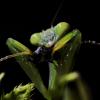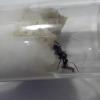I have (to my belief) a colony of myrmica incompleta right now (old picture from last year here: https://imgur.com/a/TDYkKyQ) and to be honest I have not read or seen many journals or experiences with this species. I have heard that myrmica are generally "finicky" when raising however this was not my experience at all, in fact everything was completely opposite of what LC3 said for my experience (that could just be my experience though).
I raised this colony with three queens (pleometrosis) last year because years prior I had tried raising just one queen and that never seemed to work so I thought I'd try multiple since they are polygynous. It worked fantastically (for the most part). Unlike LC3's experience the colony laid tons of eggs right away and the colony's population exploded, within the first two months I had about 30 workers.
At about the 8th - 10th worker the queens began fighting and the most dominant queen killed the other two queens so this could be why M. incompleta are less polygynous than other species but I have observed many polygynous colonies of M. incompleta in my area and I will be attempting to add queens to the colony later on.
As far as diet, humidity, temperature etc. they have been the opposite of picky. I have raised them in test tubes and they have not seemed to care much about the temperature or humidity. Both of which fluctuated quite a bit day to day in the first year I was raising them but they seemed to be fine. I have noticed for their diet that they much prefer proteins like egg, chicken, beef and insects over sugary sources. They do love the occasional drop of honey as much as the next ant but they seem to want a source of protein much more often, in any brood development stages.
For behavior, in the wild I have always thought these ants to be very non-aggressive and slow moving compared to really anything else including other myrmica species but my assumptions have changed since keeping them. Surprisingly they seem to be very aggressive and attack/swarm any food I put in their out-world within seconds, faster and more aggressive than my camponotus. Behavior often changes when the colony size changes so I will see if that stays the same as they grow.
Before keeping this species I had always wanted a species of myrmica besides this one as I thought they were slow growing, slow moving, non-aggressive, and overall not interesting. To my experience this is definitely not the case and has been a very enjoyable species to keep thus far.
A very cool added bonus with these ants is that they do have an impressive degree of polymorphism for myrmica. I have been trying to get measurements but from eye balling I have seen ants differ in a max of 2-3mm possibly 4mm.
Edited by Karma, April 26 2019 - 4:38 PM.





















